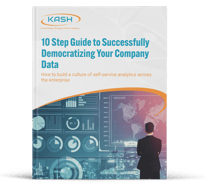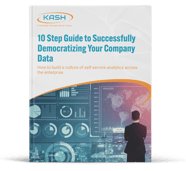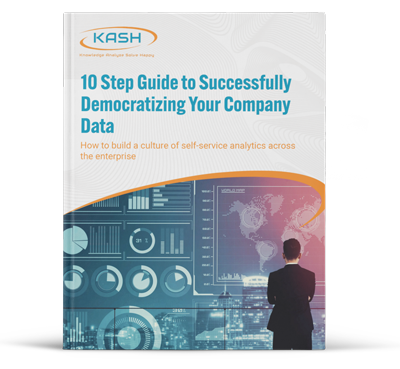Contents
Introduction
Self-service analytics can empower business leaders to make better data-driven decisions without having to always rely on IT and data teams. By democratizing corporate data and deploying audience-based analytics capabilities, users can do their own data exploration and visual analytics for identifying new insights.
However, that’s easier said than done. Most businesses have low business intelligence (BI) maturity according to Gartner's research. This can severely constrain modernization attempts. Without the expertise and the infrastructure to support self-service analytics, it can be exceptionally challenging to implement company-wide self-service analytics adoption.
Without the expertise and the infrastructure to support self-service analytics, it can be exceptionally challenging to implement company-wide self-service analytics adoption.
Studies from McKinsey and Boston Consulting Group (BCG) back that up. Both report that seven out of ten large-scale business initiatives and digital transformation fail to achieve their goals. Even in sophisticated, digitally-savvy industries, only 16% of people surveyed said their digital transformations improve performance. 7% said the progress they did make was not sustained.
Building an analytics-driven culture is essential to getting widespread adoption and use. Companies must embrace self-service data analytics at the highest level of an organization and embed it in their decision-making process. When this happens, companies democratizing their data can see significant results, including:
- Improves data access without having to burden IT teams and data scientists
- Empowers employees to make more informed decisions and extends data-driven decision-making throughout an organization
- Provides greater insights into customers, people, and processes
- Creates more agile, flexible organizations as markets and customer behavior changes
In this eBook, we will discuss how to overcome the challenges of democratizing data and successfully deploy self-service BI and self-service analytics applications across your organization.
Download a Personal
Copy of the eBook

Learn how you can unlock critical business intelligence data and build a data strategy that accelerates your business's growth.
Topics covered:
- Common challenges with business data & how to overcome them
- The current landscape of data analytics
- Recommendations
Fill out the form to receive your personal copy of the eBook.
Download the eBook
Challenges in Democratizing Data
For example, the Finance team might have a license for Tableau on the desktop. Sales might use Power BI and Marketing might use HubSpot or another marketing automation platform — all with different data sources. It’s not uncommon for different business units to come to competing decisions based on the data sets they use.
Some of the questions you may be asking include:
- What is the best BI solution for my business?
- How can I democratize data efficiently and cost-effectively?
- How do I deliver self-service analytics without creating additional burdens for the IT or data science team?
- How can I accelerate the adoption of business analytics enterprise-wide?
- How can I help business users make better decisions using analytics applications?
Answering these questions requires understanding the challenges that can arise in democratizing data. One of the biggest things that limit effectiveness is the additional burden it places on IT teams.
The Burden on IT Teams
Most organizations have multiple tools. In fact, the average company already uses 3.8 different business intelligence tools on average, while larger enterprises use more. There may be value in using specialized solutions, but each additional toolset creates an additional workload to manage and maintain your digital resources.
Companies also continue to rely on IT to create the content end-user needs. This adds to the burden, lengthens the time it takes to generate reporting, and adds significantly to the cost. Especially in an era where highly-skilled IT team members are difficult to hire and keep, you can’t afford to tie them up in low-level work.
Without a well-architected infrastructure, data can easily be siloed. In most cases, this requires separating the data layer from the application layer. This allows business analytics to continue at the user level with a single source of truth even if they use different BI products.
Yet, we often see companies attempting to solve this challenge by creating specialized data stores to address specific data requests. Then, when a new request comes in, it often requires the data to be augmented in order to satisfy the new request. Without proper governance, this can add to the complexity of the analytics environment and increase the workload substantially. It’s way too easy for data to be duplicated or get out of sync. In companies where IT teams are stretched thin, they may also skip the documentation that helps others within the organization understand the data flow.

Adding to the Tech Stack
Another common situation we see is when a new executive joins a company and wants to bring on board the toolset they are already familiar with from their previous company. Even if this new toolset was proven effective in another company, it doesn’t mean it’s the right fit for the new environment.
Every time you add in another layer, it creates additional complexity and ties up resources. It can also impact the effectiveness of employees as they may be conflicted about which tools to use or have to learn new processes.
Lack of Trust
All of this can undermine the effectiveness of the data and create distrust. This is a serious problem. If you do not have confidence in the data, you will not trust the results. A study by HFS research revealed that three-quarters of business executives do not have a high level of trust in their data.
Without trust, you can’t build a data-centric organization.

The Current Landscape
Although there are lots of tools and applications that can help leverage data and analytics, there are limited ways to solve the challenges. Most organizations rely on dedicated IT resources to meet the current and future data demands.
Data democratization takes the data out of the hands of the few and allows frontline workers to access and analyze it, but it also requires strict governance to assure data quality. Many businesses also fail to address this point when adopting self-service analytics solutions.
Failing to address these challenges effectively creates a wealth of potential problems, including:
Poor Decision Making
Businesses make decisions based on inaccessible, inaccurate, or incomplete data.
Increased Costs
The increased cost of maintaining multiple platforms, tools, systems, and data sources.
Increased Management Oversight
If you are not accurately monitoring who is using data and it is being used, you are not able to identify the issues that need to be corrected or avoid business failures. Businesses in the end will spend their time-fighting fires versus addressing issues proactively.
Lack of Knowledge Transfer
Consistency in applying data governance and ownership is crucial. Yet, too often, the knowledge and expertise to do so are in the hands of one person within an organization. Much of the knowledge of business rules are learned and no one else in the organization may have a deep understanding. So, when that one person leaves, the expertise walks out the door.
This lack of knowledge transfer can significantly impact your risk structure and stifle the continuity and progress of your analytics initiatives.
Overcoming the Challenges in Data Democratization
Organizations often try to address these challenges on their own. They may not want to invest in an outside company when developing an enterprise data analytics strategy. However, addressing these challenges may require expertise that many enterprises do not currently have. For example, they may define problems solely in terms of current needs without thinking about future analytical requirements. Or, they may default to tools and solutions they are familiar with rather than finding the best-fit products.
Working with a qualified service provider can bring a breadth of experience in solving these issues. The right provider knows what works and what doesn’t and can save you considerable amounts of time and money.
Another situation that occurs frequently is that organizations turn to the vendors of specific tools they are using for guidance. The problem is that product vendors only have experience with their products and uses which may not be the best fit. Vendors often fail to see solutions holistically and default to suggesting only their products as the solution. In many cases, this will not serve the needs of the organization or even add to the complexity of the tech stack.
Vendors often fail to see solutions holistically and default to suggesting only their products as the solution. In many cases, this will not serve the needs of the organization or even add to the complexity of the tech stack.
In the end, this can be an expensive proposition and one of the reasons why so many implementations fall short. Without the right tools and platform, adoption falls and improvements lag. This can be devastating to a business that has spent all of its time and money on implementing a new system, reengineering processes, and shifting people’s workflow, only to find that it doesn’t improve the data analysis or decision-making.
Gartner estimated that poor data quality and inefficient tools and systems can cost enterprise-level organizations as much as $15 million annually. And that doesn’t take into account the potential lost opportunity cost.
Companies may also try to salvage their investment in existing tools by hiring analytics consultants to make incremental improvements. These consultants might change the UI or clean up the data, but are not able to change the underlying problems due to a lack of an enterprise perspective or a faulty strategic plan. This can undermine trust as interfaces, processes, and front-end accessibility change, creating even greater resistance to using self-service analytics solutions.
Recommendations for Democratizing Your Company Data
Looking at all of the challenges and alternatives, we have boiled down the process of successfully implementing data democracy into these 10 steps.
The 10 Steps to Democratizing Data
1. Understand the Current Landscape
You must first assess the current landscape to determine whether your infrastructure supports data democratization or whether you need to redesign. In most cases, you will need to re-architect your infrastructure.
You’ll need to answer questions such as:
- How much data are you managing?
- How many different data sources exist?
- How are data sources interconnected (or not)?
- How will data analytics be used in different areas of your business?
- What is the level of maturity in your organization with data?
These are several factors that need to be considered when evaluating and selecting a new BI tool or platform to accommodate the entire analytical audience of the company and factor in their different levels of technical capability.
2. Understand Stakeholder Needs
A Business Intelligence application is a collection of analytics capabilities and dashboards constructed for the varying audiences you are trying to reach. Therefore, the definition, design, and construction of the BI application will vary by audience and need. This is how you address different business users' needs without proliferating tools.
This requires you to spend time understanding both business goals and stakeholder needs. Your solutions must tie back to overarching business goals.
3. Prioritize User Over Data
Promote a high level of business leader and end-user participation in the design and development of the different types of analytics they require to improve the decision-making process.
A coordinated approach across organizational, process and technological areas of a company produces greater buy-in — a key to user adoption. When end-users understand the goals and why decisions have been made, they are more likely to embrace change. Otherwise, it’s way too easy for them to default to the old way of doing things.

4. Choose the Right Platform
When choosing a platform, it must allow not only self-service analytics functionality but also the development of applications with minimal IT assistance. The “governed self-service” approach to analytics allows users to access detail but includes guardrails to ensure users do not access incorrectly formed data.
You want to invest in a platform that makes data governance easy without having to use a large, dedicated team to manage it. The right platform should easily access all enterprise data sources and incorporates the full spectrum of analytics requirements that will lead to the highest levels of user adoption.
5. Empower Team Members with Self-Service Tools
While your analytics solutions will require the involvement of the IT staff, you want to minimize the need to burden your team members with routine tasks. While they may need to be involved in processing raw data or building applications for stakeholders or consumers, you want to move as much of the data analysis process as possible as close to the end-user as you can.
Done right, this allows IT teams to manage the system and the data while providing the full self-service experience business users need to do their analysis. This relieves much of the burden on the IT and data science team and also encourages adoption by end-users.
6. Embrace People, Processes & Technology
Integration of Artificial Intelligence (AI) and Machine Learning (ML) is dependent on the foundational aspects of People, Processes, and Technology within your organization. These three components of the solution are critical to the success of any business venture, so you must ensure that you have people with an understanding and aptitude for AI & ML.
Your technology platform must support the automated processing of big data and the dissemination of actionable information and insights. You need to have a BI platform that will allow seamless integration of AI and Machine Learning models with the data and all components of the BI system.
7. Enable AI & Machine Learning Tools
The use of enabling technologies such as machine learning and AI to assist with data preparation, insight generation, and explanation enhance how users explore and analyze data within the analytics and BI platform.
CompTIA reports that 86% of CEOs consider AI a mainstream technology in organizations and that more than 91% of leading businesses are investing in AI on an ongoing basis. These tools unleash the power of analytics and business intelligence. Even if you are not employing AI and ML now, you will be in the future, so you need to prepare your system to accommodate advanced analytics.
8. Leverage the Four Levels of Business Intelligence
There are four traditional levels of business intelligence and each must be addressed in your data analytics solution.
- Descriptive Analytics — What Happened:
Uses historical data to measure performance. For example, tracking sales revenue. - Diagnostic Analytics — Why Did This Happen:
Incorporates pattern recognition to help users diagnose why something is happening. - Predictive Analytics — What’s Going to Happen Next:
Uses historical data, current trends, and modeling techniques to predict future performance. - Prescriptive Analytics — What Can We Do Better:
Prescriptive analytics recommends actions you can take in the future to affect predicted outcomes.
9. Data-Driven Culture
Ultimately, use adoption comes down to two specific strategies. Enabling self-service analytics for all users must be embraced by a company’s top leadership. It takes a data-driven culture with clear expectations of how data will be used to form decisions. Secondly, end-users must be properly trained on the various ways to do data exploration and visualization in order to extract the greatest value.
Without these two strategies, even the best-designed and implemented systems can fail.
10. Make Data Accessible
Even with a data-centric culture, however, employees need user-friendly tools that make it easy to access and analyze the data. Intuitive tools should allow fast adoption with minimal training, while continued training can help users leverage deeper insights.
Built-in data management processes are also crucial. Companies should look to democratize data and include policies and procedures for ensuring the accuracy and security of access.
Making data more accessible requires defining a roadmap to embracing governance policies across the organization, including improving data literacy.
Download a Personal Copy of the eBook

Learn how you can unlock critical business intelligence data and build a data strategy that accelerates your business's growth.
Topics covered:
- Common challenges with business data & how to overcome them
- The current landscape of data analytics in business
- Recommendations
Fill out the form to receive your personal copy of the eBook.
Download the eBook
How KASH Tech Approaches Data Democracy
Many companies have dealt with these challenges for so long that they often feel there’s no real solution. Others have been burned by entrusting consultants and providers to help them solve problems without getting the results they need or expected.
At KASH Tech, our methodology is different from the way other companies approach this process. We focus a significant amount of work on the front end to understand your company and goals, so we can address specific needs.
While many of the tech solutions are similar, how each is deployed, works with your data, and aligns with your goals is unique. It takes a thorough investigation of the business user’s requirements and business process to design the right solution that addresses their specific needs.
We maintain the focus on the people as well as the methodology. Forensic investigation will help us understand your architecture and infrastructure, but we also must account for the human element. It’s not about the implementation and transaction, it’s about solving specific problems for key stakeholders that they currently have. We take the time to understand the full range of challenges and develop a plan to deliver the expected results and value.
KASH Tech is also tool-agnostic. We have experience and relationships with leading data and analytics vendors, so we can suggest the right set of tools that work best for you.
By focusing on a holistic approach, we can help organizations develop a framework to empower frontline employees with the data they need to make better decisions. We stand behind our work, using proven methodologies and processes to ensure success. We guarantee our work will be delivered to meet your goals.
There is a solution that will work for your organization. Request a data and analytics discovery call with the experts at KASH Tech today.
To explore further, download our Advanced Analytics Playbook: How to Unlock Breakthrough Business Insights.

